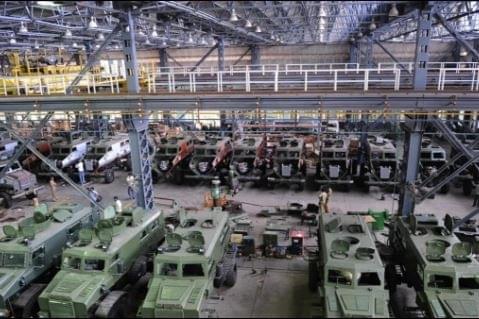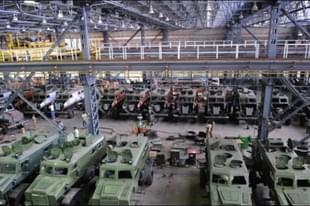Defence
Tamil Nadu Defence Industrial Corridor – A Reality Check
S Shekhar
Jun 18, 2018, 03:23 PM | Updated 03:13 PM IST
Save & read from anywhere!
Bookmark stories for easy access on any device or the Swarajya app.


Defence Minister Nirmala Sitharaman said the first step towards Tamil Nadu’s entry into defence manufacturing would be consolidating the expertise already available in the state in the automobile manufacturing sector, and upgrading skills and technology – thus sowing the seeds for the establishment of what is now loosely termed as Tamil Nadu Defence Industrial Corridor.
She recommended this at a Defence Industry Interaction in Chennai in mid-February this year in response to Tamil Nadu Chief Minister Edappadi K Palanswami’s call for the establishment of a major defence manufacturing unit in Tamil Nadu
Following this, there have been quick follow-ups by the the Ministry of Defence (MoD), which is said to have engaged a top consultancy firm for preparing a detailed project report (DPR) to set up a defence production corridor in Tamil Nadu. The defence quad or quadrilateral in Tamil Nadu is one of the two defence production corridors announced by Finance Minister Arun Jaitley in the 2018-19 budget.
The corridor, which is being organised as a quadrilateral, is expected to extend from Chennai, Hosur, Coimbatore, Salem and Tiruchirapalli facilitating the state’s manufacturing sector to participate in defence production. Subsequently, MoD initiated a series of interactions at Hosur, Coimbatore, Salem, Chennai and Tiruchirapalli with the industry and Ministry of Micro, Small and Medium Enterprises (MSMEs), where senior officers from MoD, representatives of Hindustan Aeronautics Ltd, Bharat Electronics Ltd, Bharat Earth Movers Ltd and Ordnance Factories, etc participated.
Where Do We Stand Today? – A Reality Check
The success of any endeavour depends on four ‘P’s – purpose, product, people and processes. Let us examine the current status of the proposed Tamil Nadu Defence Industrial Corridor from these four perspectives.
Purpose
There should be no doubt in anyone’s mind that the primary purpose of setting up of the defence industrial corridor was to enhance the operational readiness of the combatant units of the Indian Armed Forces, by reducing the current reliance on imported military hardware, including weapon platforms, systems and sub systems, even components and spares.
Stemming from this is the need for expanding our defence manufacturing base. The defence manufacturing base in turn currently consists predominantly of the Defence Public Sector Units (DPSUs), which in turn depend on myriad Tier 2 and Tier 3 vendors, most of them MSMEs . These DPSUs are supported by the Defence Research and Design Organisation (DRDO) for their design inputs.
Thanks to recent initiatives of the government, like the Make in India programme, and the revised Defence Procurement Policies and Procedures, some private sector industries have entered the defence manufacturing domain, many of them, understandably with little or no experience or expertise in this highly complex domain.
Obviously the spin off benefits of the defence industrial corridor for Tamil Nadu would include the revival of “sick” industrial units among the MSMEs, skill development, creation of more jobs, saving to the national exchequer, and last but not least a generous boost to the economy.
Reality Check
Is there clarity both at the Centre and state levels on the purpose of the corridor? Who are the stakeholders at the Central and state governments? Have all the stakeholders of the proposed corridor been identified? Has any effort been made to get all the stakeholders on the same page regarding the purpose?
Product
At one end of the defence corridor is the platform on the battle field, as in armoured fighting vehicle or artillery gun, in the maritime space, the ship or submarine, and in the air the fighter aircraft or helicopter. At the other end is the shop floor of the participating MSME/platform integrator as the case may be. Obviously the product is different, depending on which end of the spectrum one is considering. On the shop floor, it is the contract or purchase order, which will generate the hiring of personnel, upgradation of plant and machinery, acquisition of bill of material etc. On the battlefield is the ready to use availability of the weapon platform, spares etc. Between the two, there is a virtual chasm.
Unlike in the familiar automotive sector, where the cars are manufactured in various models or variations depending on customer preference, in defence manufacturing, the product sought by the end user is dependent on various factors, including perceived enemy capabilities, operating terrain etc. These are translated by the professional directors at services headquarters, and then converted into design specifications, by the relevant design organisations, and then conveyed to the platform manufacturers for new acquisitions and purchase organisations in case of replacements during repairs and upgrades.
At the shop floor end, the purchase order is received after a back breaking, time-and-effort-consuming odyssey through a process of registration with ordering agencies, getting samples approved after rigorous testing and evaluation, bidding for tenders, being designated “L1”, participation in excruciating price negotiations, providing necessary bank guarantees etc.
Obviously, in many cases, the volumes required are not attractive.
Reality Check
Is there a monitoring system in place to evaluate success parameters in conversion of need into satisfaction, both at the battle field and shop floor ends?
Who is to design this monitoring system?
Who is to implement it?
People
At the end of the day, it is ‘people’ who drive a programme and will be benefited by it. As described earlier with regard to product, there are literally thousands of people hopefully working towards the success of the Tamil Nadu Defence Industrial Corridor spanning the space between battlefield and shop floor. These include:
End users, service headquarters, Ministry of Defence and its many constituents, like Department of Defence Production, DRDO DPSUs, ordnance factories DGQA etc, state governments and its myriad departments, industry, MSME, electricity board, pollution control board, inspectorate of factories, and other agencies like TIDCO, SIDCO et al ,to name but a few. Also, the various industry bodies claiming to represent the interest of the defence sector – there are so many of them that the Defence Minister advised them to form one single representative body (thus apparently giving rise to the recent formation of the Society of Indian Defence Manufacturers or SIDM). Last but not least the manufacturers themselves
Reality Check
Are all the above elements dealing with the corridor manned by qualified, skilled, experienced, motivated people in their respective spheres of activity?
Do they have continuity in office for a reasonable period of time?
More importantly, do they speak to each other, cutting across organisational barriers, speeding up processes that will ensure the security of the nation?
Processes
In the highly technology-driven environment that we live in today, with social media, and television channels bringing almost the mundane activities of our daily lives under public scrutiny, and with the kind of money involved in defence purchases, it is obvious that not only is transparency ensured, but proper usage of public money. It goes to the credit of the present government that many initiatives to streamline processes and procedures have been introduced.
But since we are still evolving in defence self reliance, all this is still ‘work in progress’. What is important is that these processes and procedures have to be seen from the lens of the two ends of the defence corridor – the man at the machine gun, and the man at the lathe. Neither of them have the luxury of looking at processes and procedures. The former wants his gun to fire when he wants it to fire and the latter wants the product he has put his heart and soul to create, to reach the battlefield on time. Both are driven by the same purpose – ensuring the nation’s security.
Reality Check
Is someone, somewhere, using the “farm to fork” analogy, keeping track of the cycle time in which the end user gets what he wants, viz the weapons to wage war, when required, and the industrialist gets his return on investment?
Is this input being made available to the policy makers at South Block?
Has someone drawn up an actionable time-bound roadmap for the successful implementation of the Tamil Nadu Defence Industrial Corridor?
Success has many fathers, failure is an orphan. The establishment of the Tamil Nadu Defence Industrial Corridor is an important step both for the security of our nation, as well as for the development of Tamil Nadu. Its success cannot be achieved by merely conducting seminars, making public announcements, drawing up of project reports by the so called experts etc. It demands hard core proven experience in the three areas of the programme – defence, industry and Tamil Nadu. In addition, it needs the passionate involvement of the MSMEs who are the backbone of industry, and a greater and more direct interaction of them with the end users viz the Armed Forces.
Most importantly, the establishment of Tamil Nadu Defence Industrial Corridor cannot be driven from New Delhi. It needs the expertise of professionals with hands on experience in defence, industry and last but not least, in Tamil Nadu.
Let us not worry about the claimants for success, when the Tamil Nadu Defence Industrial Corridor succeeds on the ground. Let us all collectively work to prevent its failure.
S Shekhar is Commodore (Retd). and Director, Centre for Advancement of Sceince, Technology, Law and Engineering (CASTLE)





